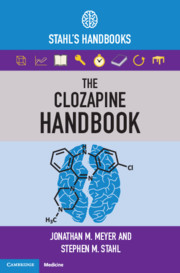Book contents
- The Clozapine Handbook
- The Clozapine Handbook
- Copyright page
- Additional material
- Contents
- Foreword
- Introduction
- 1 The Efficacy Story: Treatment-Resistant Schizophrenia, Psychogenic Polydipsia, Treatment-Intolerant Schizophrenia, Suicidality, Violence, Mania and Parkinson’s Disease Psychosis
- 2 Addressing Clozapine Positive Symptom Nonresponse in Schizophrenia Spectrum Patients
- 3 Initiating Clozapine
- 4 Discontinuing Clozapine and Management of Cholinergic Rebound
- 5 Binding Profile, Metabolism, Kinetics, Drug Interactions and Use of Plasma Levels
- 6 Understanding Hematologic Monitoring and Benign Ethnic Neutropenia
- 7 Managing Constipation
- 8 Managing Sedation, Orthostasis and Tachycardia
- 9 Managing Sialorrhea
- 10 Managing Seizure Risk and Stuttering
- 11 Managing Metabolic Adverse Effects
- 12 Fever, Myocarditis, Interstitial Nephritis, DRESS, Serositis and Cardiomyopathy
- 13 Managing Enuresis and Incontinence, Priapism, Venous Thromboembolism, Neuroleptic Malignant Syndrome, Tardive Dyskinesia and Obsessive Compulsive Disorder
- 14 Eosinophilia, Leukocytosis, Thrombocytopenia, Thrombocytosis, Anemia, Hepatic Function Abnormalities
- 15 Special Topics: Child and Adolescent Patients, Elderly Patients, Patients With Intellectual Disability, Pregnancy and Risk for Major Congenital Malformation, Lactation, Overdose, Postmortem Redistribution
- Index
- References
11 - Managing Metabolic Adverse Effects
Published online by Cambridge University Press: 19 October 2021
- The Clozapine Handbook
- The Clozapine Handbook
- Copyright page
- Additional material
- Contents
- Foreword
- Introduction
- 1 The Efficacy Story: Treatment-Resistant Schizophrenia, Psychogenic Polydipsia, Treatment-Intolerant Schizophrenia, Suicidality, Violence, Mania and Parkinson’s Disease Psychosis
- 2 Addressing Clozapine Positive Symptom Nonresponse in Schizophrenia Spectrum Patients
- 3 Initiating Clozapine
- 4 Discontinuing Clozapine and Management of Cholinergic Rebound
- 5 Binding Profile, Metabolism, Kinetics, Drug Interactions and Use of Plasma Levels
- 6 Understanding Hematologic Monitoring and Benign Ethnic Neutropenia
- 7 Managing Constipation
- 8 Managing Sedation, Orthostasis and Tachycardia
- 9 Managing Sialorrhea
- 10 Managing Seizure Risk and Stuttering
- 11 Managing Metabolic Adverse Effects
- 12 Fever, Myocarditis, Interstitial Nephritis, DRESS, Serositis and Cardiomyopathy
- 13 Managing Enuresis and Incontinence, Priapism, Venous Thromboembolism, Neuroleptic Malignant Syndrome, Tardive Dyskinesia and Obsessive Compulsive Disorder
- 14 Eosinophilia, Leukocytosis, Thrombocytopenia, Thrombocytosis, Anemia, Hepatic Function Abnormalities
- 15 Special Topics: Child and Adolescent Patients, Elderly Patients, Patients With Intellectual Disability, Pregnancy and Risk for Major Congenital Malformation, Lactation, Overdose, Postmortem Redistribution
- Index
- References
Summary
The primary use of clozapine is for schizophrenia spectrum patients with a history of suicidality or treatment-resistant psychosis. Although clozapine itself imposes significant metabolic burden, this is overlaid on the twofold higher rates of metabolic disorders (type 2 diabetes mellitus, metabolic syndrome) and twofold greater standardized mortality rates for cardiovascular disease in this patient population. Multiple factors contribute to this risk profile including lifestyle (e.g. smoking, dietary habits, sedentary behavior), metabolic effects of medications, and biological aspects of schizophrenia itself detectable in treatment-naive patients. Given clozapine’s metabolic impact, combined with the reality that patients may remain on clozapine throughout their lives, ongoing management of cardiometabolic risk is integral to the care of clozapine-treated individuals. Despite this confluence of medication and disease-related risk, the use of clozapine is associated with lower mortality rates from unnatural and natural causes. Investigators compared mortality trends in 14,754 individuals with schizophrenia, schizoaffective disorder or bipolar disorder followed in London from 2007 to 2011. There was a significant association between clozapine use (n = 748) and lower mortality even after controlling for confounders including clinical monitoring and disease severity (adjusted hazard ratio 0.4; 95% CI 0.2–0.7; p = 0.001). This adds to prior data from an 11-year Finnish study which showed that clozapine markedly reduces suicide-related mortality, while no pronounced differences for ischemic heart disease mortality were found between antipsychotics.
- Type
- Chapter
- Information
- The Clozapine HandbookStahl's Handbooks, pp. 204 - 223Publisher: Cambridge University PressPrint publication year: 2019

